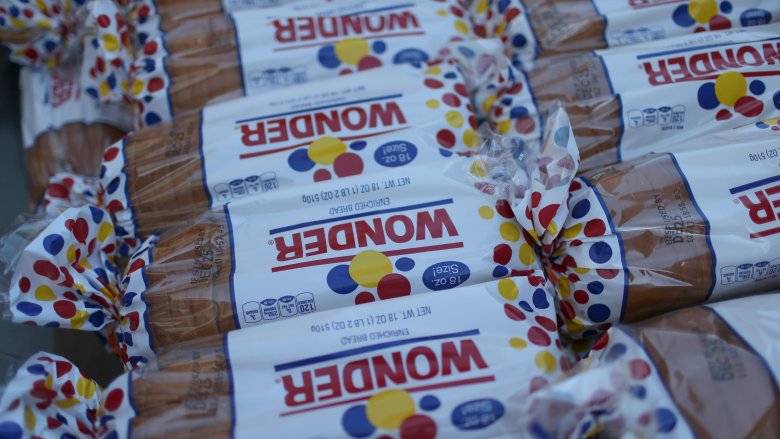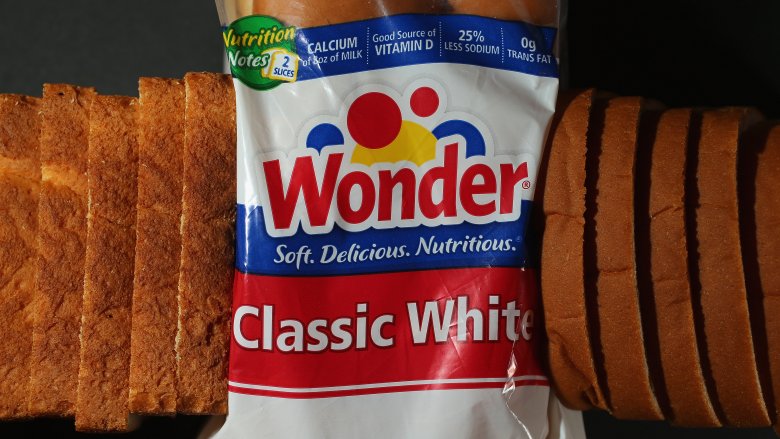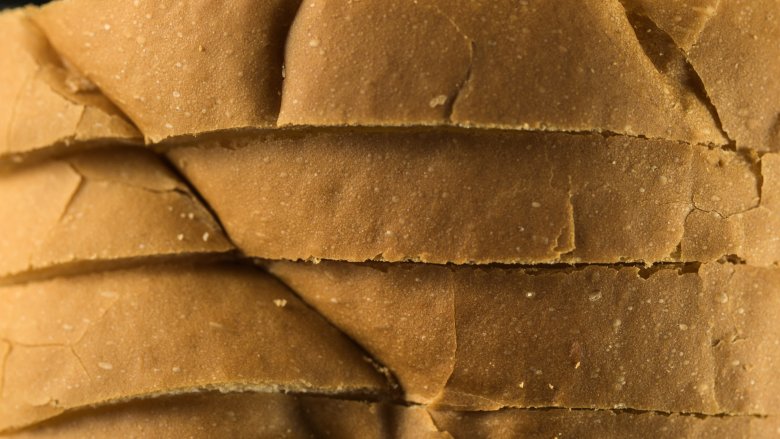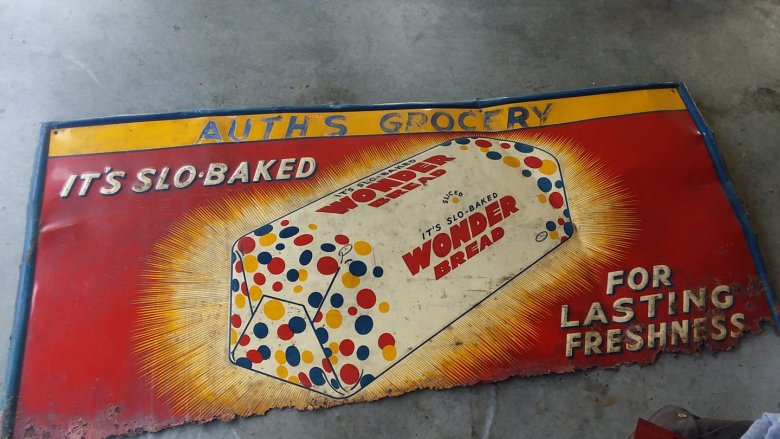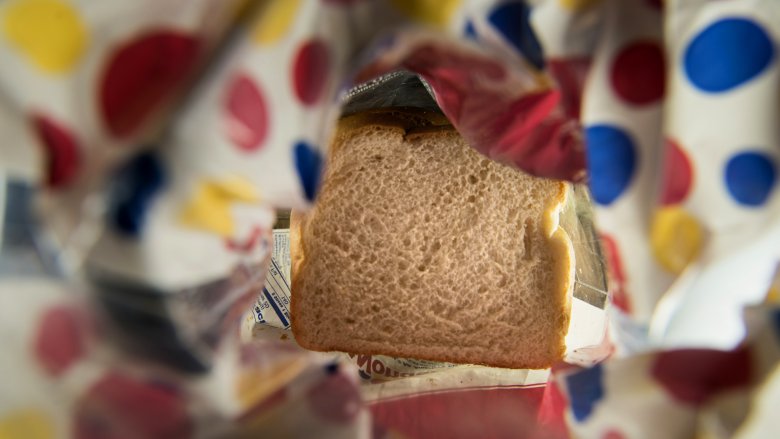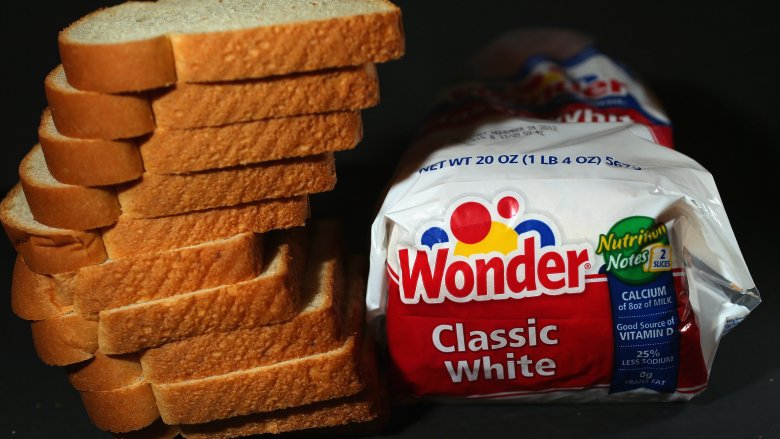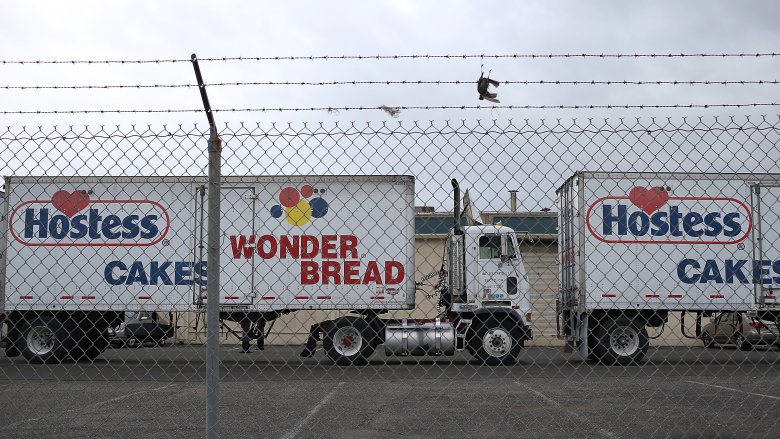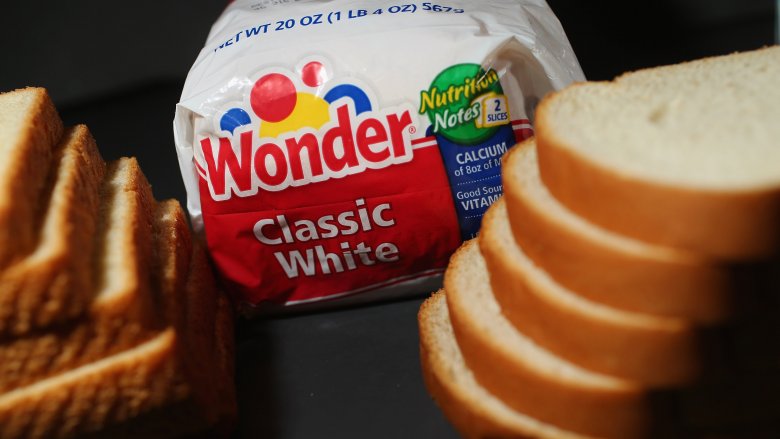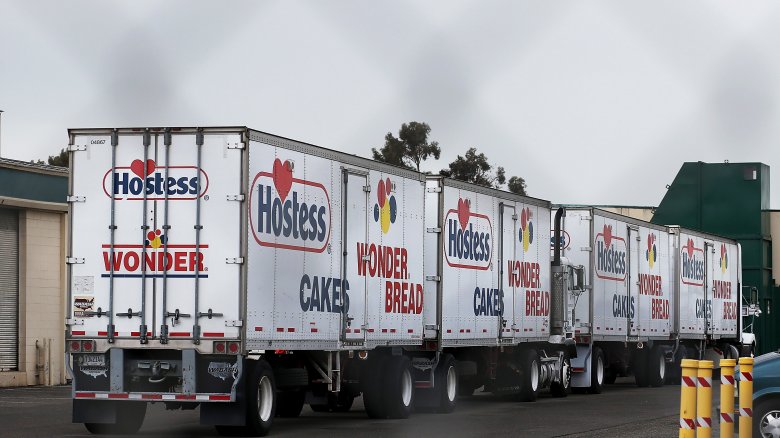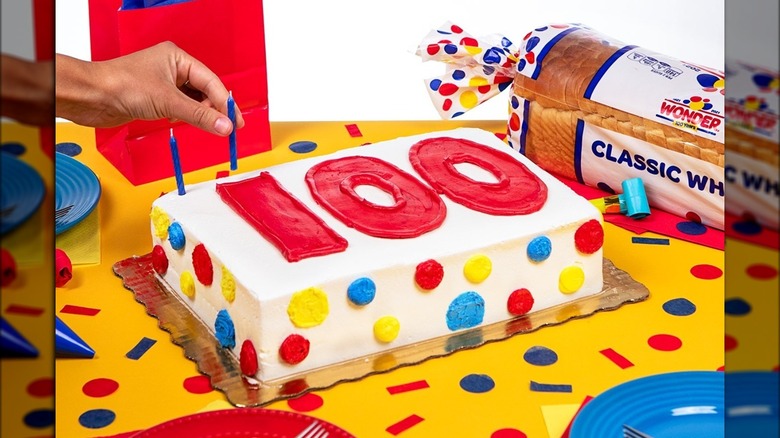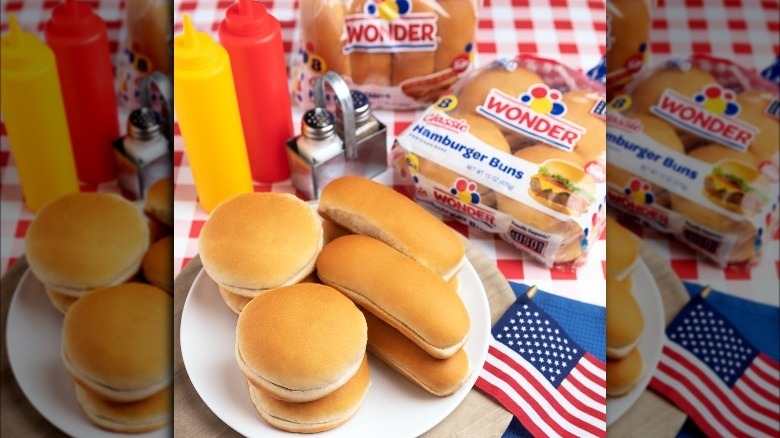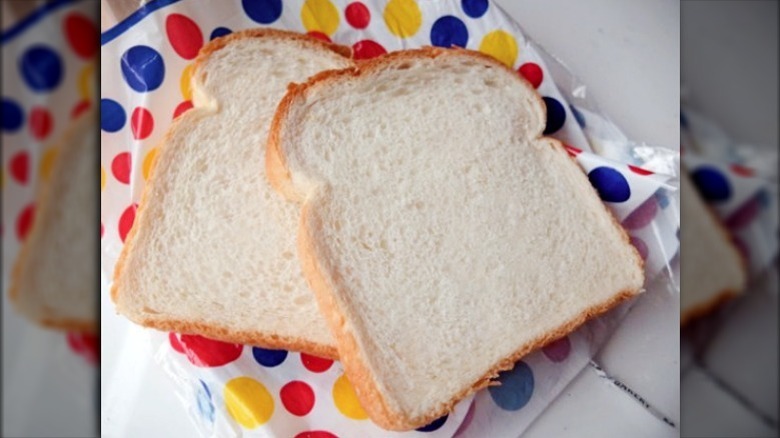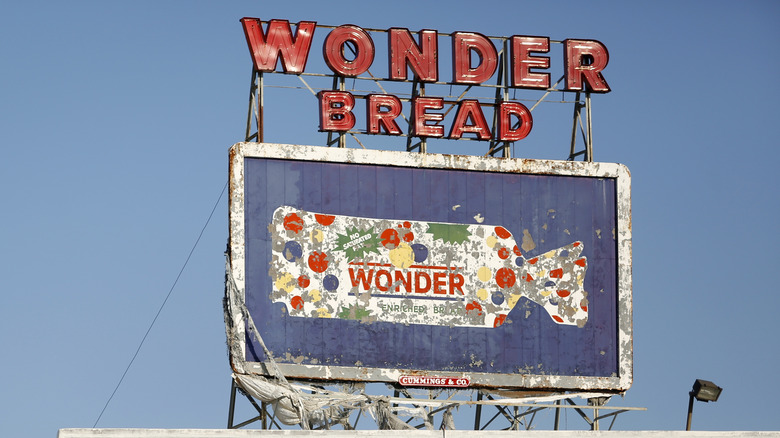The Untold Truth Of Wonder Bread
While Wonder Bread was not the country's first manufacturer of sliced, white bread, it's certainly the brand most commonly associated with it. When Indianapolis residents were promised the coming of "wonder" in an ad released in May 1921, no one knew the entire country would soon experience that same wonder for years and years to come.
Wonder Bread has been around for more than a century, and most Americans still recognize the iconic colorfully packaged loaves as a staple of their childhood. Wonder Bread has a pretty interesting history, and it almost went fully extinct in 2012. It's been steadily back on shelves but the path since its inception in the '20s is definitely more complicated than its plain white interior. Want the underground facts about the bread you used to effortlessly form into balls to hurl at your fellow classmates during lunch period in elementary school? Then read on for the untold truth of Wonder Bread.
The Wonder Bread name was inspired by hot air balloons
Ever wonder how this bread got the name Wonder? Well, a branding executive for Taggart Baking Company named Elmer Cline was really inspired by hot air balloons, especially the ones he saw at the International Balloon Race held at the Indianapolis Speedway in 1921. The glorious wonder of witnessing hundreds of hot air balloons dot the sky led him to suggest naming the now iconic white loaves Wonder Bread.
Not one to forget its branding roots, Wonder Bread has maintained its utmost respect for hot air balloons. In 2001, it commissioned its own company hot air balloon with the Wonder Bread logo emblazoned across it. The balloon visits states across the country and, of course, Wonder Bread encourages people to document sightings of the Wonder balloon on social media with the hashtag #SpotTheWonder. Pretty sure Elmer Cline would be pretty proud.
Wonder Bread was thought to be more clean than homemade bread
Lucky for Wonder Bread, its heyday happened before the term "processed food" was a bad word. Old school bread was made in the home. Eventually bakeries started do the bread making, but they weren't the cutesy bakeries we think of today. Early industrial age bakeries weren't exactly spic and span, and bakers sometimes allegedly compromised the quality of the product when they cut corners to save dough ("dough," in this instance, is both a cheeky term for money and the literal dough of bread). They may have even added stuff like sawdust to stretch what they had.
When food-borne illnesses like cholera and typhus started to take people down at the turn of the century, folks started getting really paranoid about what was in their food. This fear often led to the nixing of bread baked locally. In short, folks worried about the safety of consuming what we would now probably refer to as locally sourced bread. Instead people turned to "factory bread," which they envisioned as being kneaded by the palms of angels in a giant, pristine, sparkling industrial kitchen, or something along those lines. The whiteness of staple bread brands like Wonder Bread only served to further solidify its reputation for purity and cleanliness.
Wonder Bread didn't invent sliced bread
Wonder Bread might have capitalized on the concept of sliced bread, but it certainly didn't invent it. A man named Otto Rohwedder invented the first bread slicing machine (built to slice bread by the loaf) in 1928. A lot of bakers were skeptical though. Who's gonna care about their bread being sliced? Um, turns out, everyone. Finally a bread making outlet in Missouri, the Chillicothe Baking Company, took the plunge and gave Rohwedder's invention a go 'round. Ads promoting their "Kleen Maid Sliced Bread" praised the loaves for their convenience and efficiency. Sliced bread was a hit. It was the greatest thing since... well, we're not sure exactly what or who held the title for "greatest thing" before sliced bread took over and maintained top billing.
It was such a hit that by 1930, Wonder Bread was cranking out its own slicing machines, and in turn its loaves of sliced white bread, which became an American staple. While sliced bread had already proven itself worthy, Wonder Bread arguably took it to a whole new level of fame, which is why it's often associated with this then-novel concept.
Wonder Bread loaves were sold unsliced during World War II
Sliced Wonder Bread was seemingly having the time of its life in America, until 1943. For about two months of that year, it took a hiatus from the shelves of grocery stores. Why did Wonder Bread's star sliced loaf go out of sight? It was World War II and the US government decided our country needed both the manufacturing power and the materials dedicated to bread making and slicing to be instead dedicated to making weapons. Lawmakers issued a ban of sliced bread. Steel was needed for ammo, not bread slicers. Even the wax paper used to hold the sliced loaves together was deemed a necessity for the military.
They also thought that if people couldn't get their bread pre-sliced anymore like they had grown accustomed to, they wouldn't buy as much bread. In turn, the demand for wheat would go down, which would decrease the price (flour had seen a 10 percent increase in cost) and give the military access to a lot more wheat.
Eventually the same year it was banned it was allowed to return. The government acknowledged that the savings from taking away sliced bread were not substantial. And the legendary Wonder Bread was able to resume slicin' and sellin' with fervor.
Wonder Bread wasn't always enriched
In the early 1900s, a disease referred to as pellagra was wreaking so much havoc, medical professionals at the time deemed it an "epidemic." Essentially, the individuals suffering were thought to be deficient in vitamin B3, and experiencing symptoms like dementia, dermatitis, diarrhea, and ultimately, death. While the cause of pellagra wasn't understood until decades later, experts then associated it with the lack of vitamins in the staple food southern Americans were consuming — white bread. Right before the initial pellagra outbreak was the beginning of the degermination of a staple element to that bread, corn. The brown bread that had been stripped to white bread got blamed.
The FDA got involved when it instigated its "flour hearings" in 1940. Experts convinced bread makers to find a way to basically add back into white bread the vitamins and nutrients it had been robbed of, namely thiamin, riboflavin, and nicotinic acid. Thus, bread became enriched (and was required to be labeled as so), and pellagra was seemingly eradicated. It was seen as a health victory and Wonder Bread being a well-known white bread brand at the time became a hero.
One 1952 commercial for Wonder Bread promised eight health benefits
There's a slim chance of ever seeing the white flour products of today advertising to consumers by promoting their health benefits. Most tap into nostalgia, or just tastiness. However, in its early days, Wonder Bread definitely tried to woo consumers with promises of good health. One retro Wonder Bread commercial from the 1950s promises eight perks to pounding the white stuff — protein, calcium, phosphorous, iron, vitamin B1, vitamin B2, niacin, and energy — and also alleges how much other food it would require to get those much-needed elements to "build strong bodies."
Today, Wonder Bread is encouraging folks to "feed their joy" in its commercials. Oh, and of course, they tap into the whole "wonder" motif with a boy on a trampoline turning into a man in space when he takes a bite of a sandwich made with Wonder Bread. It's certainly a far cry from the "eat this bread because all our additives will make your bones grow" marketing route.
A 1998 lawsuit accused Wonder Bread of racism
In 1998, Wonder Bread wasn't in the spotlight for being a beacon of conveniently packaged grub. Instead, it was tossed into the nation's legal system when 15 black employees at one of the company's plants sued for discrimination. The workers claimed that their white supervisors engaged in racist behavior including not allowing the black employees to gather together for fear of them forming a gang, telling racially charged jokes, and withholding promotional opportunities. They were asking Wonder Bread, its then-parent company, Interstate Brands, Corp, and five of the local San Francisco plant managers, to fork over $260 million in damages.
In 2000, a judge decided to award 17 of the plaintiffs, which had grown from 15 to 21, $120 million in punitive damages. All 21 were also awarded $11 million for lost wages, pain, and suffering due to discrimination. Interstate Brands said at the time that they planned to appeal the decision.
It became difficult for Hostess to uphold the health benefits of Wonder Bread
In 2010, Wonder Bread's then-parent company Hostess Brands was trying to convince the American public that their white bread was indeed (once again) a healthy choice. Advertisements promised perks like vitamin D, calcium, and fiber gained through eating the bread. By that time, though, nutrition experts (and anyone who hadn't been living under a rock) knew that those virtuous qualities Wonder Bread was touting were actually additives put into the bread after it had been scraped of all nutritional value in the whitening process. Basically, everyone knew what "enriched" meant by this point.
Wonder Bread sales had been declining — they were down 15% in 2009 — so Hostess was definitely grasping at straws for ways to market the bread to now health-savvy American eaters. Most had become hip to the fact that there were better ways to consume vitamins, and it was in foods where they were naturally occurring. There were even dietitians pointing out that there is such a thing as too many vitamins. Wonder Bread and Hostess had to do more to convince Americans who had been witnesses to the whole wheat gospels that there was still value in their sliced, white carb missiles.
Flowers Foods Inc saved Wonder Bread after Hostess Brands went belly up
Can you believe Wonder Bread left us for almost a full year? When the bread's parent company Hostess Brands went officially out of business in 2012, Wonder Bread ceased to line the shelves of supermarkets. Thankfully, a savior swooped in. Flowers Foods Inc., which still owns Wonder Bread today, acquired five of Hostess's bread brands, many of which people were very upset to see go when Hostess called it quits.
Flower Foods decided to recapture the nostalgia associated with Wonder Bread by returning to its original packaging and even utilizing an early version of its recipe. It returned to shelves in September of 2013. It seems as though it's here to stay thanks to the help of Flower Foods, and perhaps people's willingness to support the bread after experiencing the sad reality of it not being available. You don't know what you got 'til it's gone — right, Wonder Bread?
Wonder Bread celebrated its 100th anniversary by giving back
Wonder Bread celebrated its 100th anniversary in 2021, commemorating the milestone in generous fashion. In May 2021, the company announced it was partnering with the nonprofit organization AdoptAClassroom.org on a new initiative called "Wonder of Science" (via AP News). Through the program, several middle and high school science classes throughout the country held virtual events with Emily Calandrelli, host of the Netflix children's educational show, "Emily's Wonder Lab." During these virtual classes, Calandrelli demonstrated various science experiments and showed students how to conduct them safely at home. In addition to sponsoring these free online classes, Wonder Bread donated $10,000 to each participating school to improve its science program and purchase new equipment. In total, Wonder Bread donated $100,000 to schools in Pennsylvania, Massachusetts, Connecticut, Georgia, and New York.
"There was no better way to celebrate our 100th anniversary than to pay it forward to teachers and students, with the help of our partners, Emily, and AdoptAClassroom.org," John Steed, Flowers Foods' senior vice president of legacy brands, said in a statement to AP News. "Wonder Bread is proud to be a part of countless childhood memories, and we're dedicated to promoting the sense of wonder that comes with learning about the world as a child. Our hope is that each of these events we've put together throughout the year so far will inspire kids to be curious and learn more."
Wonder Bread is a long-time partner of the USO
By now, we know all about Wonder Bread's generous ways, and no organization has benefitted more from the company's philanthropic efforts than the United Service Organizations (USO). The bread maker has been a longtime partner with the nonprofit organization that provides aid and services to millions of military members and their families. In 2019, Wonder Bread teamed up with Tastykake for their "Deploy the Joy" campaign, which featured prominent in-store grocery displays supporting the USO, as well as limited-edition, branded packaging. As part of the campaign, the companies made a $1 million donation to the nonprofit.
"We consider it a privilege to support the USO's mission to strengthen America's military service members by keeping them connected to family, home, and country," said Debo Mukherjee, Flowers Foods' chief marketing officer, in a statement about the campaign. "Wonder Bread and Tastykake have a long history of supporting the military, and we're proud to continue the tradition with this commitment to the USO."
This was just the latest in a long line of partnerships Wonder Bread has formed with the USO. In 2018, the brand announced its "Camo for the Cause," initiative complete with a $250,000 donation. Prior to that, in both 2011 and 2012, the company held a "Wonder Bread Heroes" campaign that promoted and supported USO programs.
It now makes a variety of bread products
When you think Wonder Bread, you may think of the iconic, snowy white slices of sandwich bread. But these days, Wonder Bread is so much more.
In 2006, the brand stepped out of its white-coated box and introduced two whole wheat versions of Wonder Bread (via CBS). The move came amid a shift in Americans' diets toward healthier options. The new breads, made with white whole wheat flour, contained 2 grams of fiber per slice. Years later, Wonder Bread doubled — or should we say, tripled — down on its wheat efforts. In 2012, the company introduced three new wheat bread products: Wonder 100% Whole Wheat, Honey Wheat, and Wheat Sandwich. According to Perishable News, the products contained no artificial colors, flavors, or preservatives, 0 grams of trans fat, and 25% less sodium than traditional wheat breads.
Wonder Bread has continued to expand its product line ever since its dive into the wheat bread world, most notably, by thinking of bread options outside of its iconic sandwich variety. The brand now offers everything from hamburger and hot dog buns, to sub and Philly steak rolls, as well as dinner rolls and English muffins.
Wonder Bread tweaked its recipe
There's always room for improvement, so even though it had been satisfying the needs of bread eaters for decades, Wonder Bread tweaked its recipe in 2009 to make its signature items healthier. According to Baking Business, more calcium and vitamin D were added to Wonder Classic and Wonder Classic Sandwich bread. The reformulated recipe meant two slices of Wonder Bread now contained the same amount of calcium as an 8-ounce glass of milk or approximately 30% of an individual's daily recommended intake. Drug Store News reported at the time that most Americans were not consuming enough calcium.
"Balancing the food your family enjoys while providing the nutrition you want them to have can be difficult," Rich Seban, chief marketing officer of then-Wonder Bread maker, Interstate Brands, said in a statement to Drug Store News. "For more than 85 years, Wonder has been a staple in American households with a long history of identifying ways of enhancing the nutritional value of bread. Wonder's added calcium and vitamin D offerings reinforce the brand's continued focus on health as it continues to expand its menu of great tasting, healthy choices for the whole family. Giving your family the nutrition they need never tasted so good."
Several Wonder Bread factories have shut down in recent years
Although Wonder Bread is still going strong more than a century after first being introduced, the same cannot be said for the factories that produce the grocery store staple. Several notable Wonder Bread manufacturing sites have shut their doors in recent years.
In 2004, the 180,000-square-foot factory in Buffalo, New York shuttered, according to Atlas Obscura. The building had been in operation since 1923. Wonder Bread turned the lights off at two more factories in 2009, one in Columbus, Ohio and another in Springfield, Missouri (via Columbus Business First). Just two years later, the historic Wonder Bread factory in Jamaica, Queens, NYC, which had stood for 130 years, was closed (via Gothamist). And finally, a Wonder Bread factory in the medical district of Memphis, Tennessee shut down in 2013, according to the Memphis Daily News.
At least one old factory is getting a second, more luxurious life. The New York Daily News reports that a former Wonder Bread plant in Hoboken, New Jersey has been transformed into a luxury apartment building, known as Wonder Lofts. The building served as a bakery from 1909 until the late 1960s. Instead of bread, it now offers apartments costing upwards of $2.4 million.
